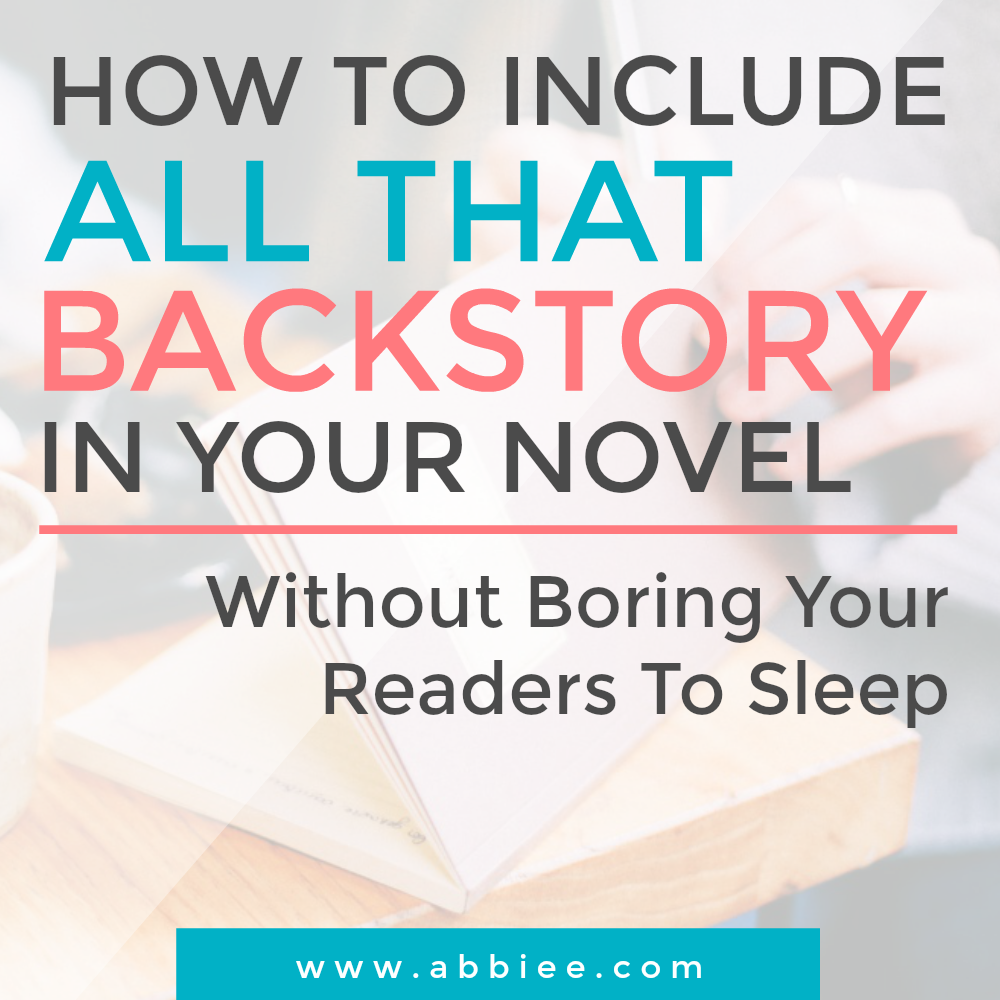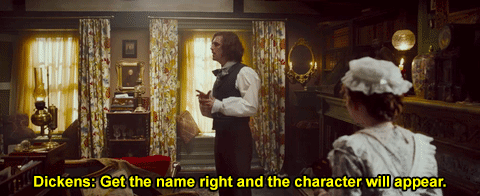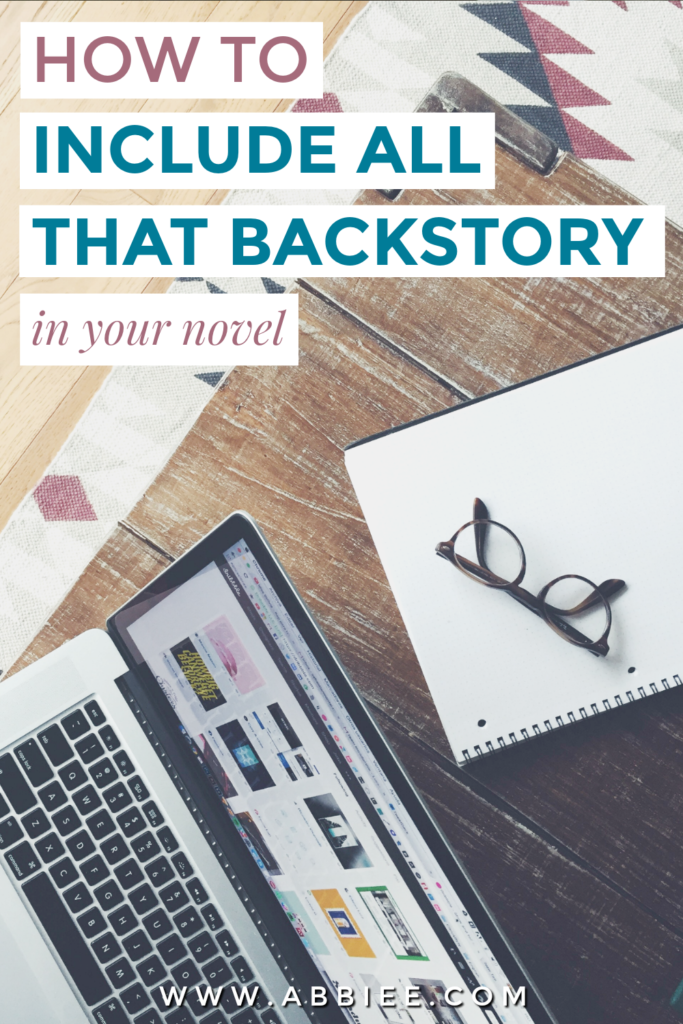Backstory: the skeleton in every writer’s closet. The thing we hate to admit we’ve written thousands of words of…only to shove it under the rug, brush the dust off our hands, and say: “Nobody needs to read all that.” I’ve heard it from many articles, blog posts, and influential voices in the writing community: “you don’t need backstory because it distracts from the REAL story and thus bores your reader to sleep.” But…I beg to differ.
I’ve always loved writing backstory. Give me a character with a name and a face and I’ll construct a detailed biography of their entire life leading up to this moment — their hopes, dreams, fears, and all the events that shaped the latter. I’ve written backstory not only for my own books, but for fan fiction and for stories I haven’t written yet (or stories I wrote a long time ago that belong in the compost pile.) So as you can imagine, my hopes have always been a bit dashed by that popular writing advice: “backstory is boring and slows down your story.”
Really? Does it?? Or is there a way to use backstory like oil in a lamp — lighting a flame to illuminate the true meaning behind everything our characters say and do? Is there ANOTHER WAY to use backstory — maybe even ALL of it — without distracting from the present… instead enhancing the present? I BELIEVE THERE IS A WAY. And that’s what we’re going to explore today. It’s a deep dive, so grab some scuba gear and let’s jump right in.
WHY IS BACKSTORY IMPORTANT?
Imagine this scenario for a moment: you’re at the mall, and a woman approaches you and asks if you know what time it is. The woman has dark brown eyes, an anxious look on her face, and she is wearing a red t-shirt and skinny jeans. You pull out your phone, check the time, and tell her. She says “thanks” and walks away. Pretty meaningless interaction, right?
Now imagine the same scenario, slightly different: instead of a stranger approaching you, it’s someone you’re very close to — sibling, best friend, mom or dad… let’s use a sister, for example (because I’m very close to my sister so this is easier for me lol.) Let’s say you have a sister and you’re at the mall together and she approaches you with an anxious look on her face and asks, “Do you know what time it is?” Not only do you have the answer of “it’s four-thirty,” but you have a billion questions to go with it.
“Is something wrong?”
“Why do you want to know?”
“Do you want to leave?”
“Are you okay?”
All questions that you would (hopefully) never ask the stranger woman in the red shirt. Why? Because your sister asking the same exact question with the same exact look on her face gives you MUCH more information: she gives context. Context is how we measure importance and how we make sense of the world around us. Your sister is the most laid-back, spontaneous person you know. She doesn’t wear a watch because she doesn’t care what time it is, ever — and she isn’t carrying a phone because she does this thing every so often where she goes “off the grid” for a week, to reconnect with life. Why does she look so anxious? When you set off for the mall this morning, she was in such a good mood.
See what happened? All of a sudden, a meaningless, ordinary interaction with a stranger turned into a surprising event with your sister…and there is only one difference involved: backstory.
You know your sister, better than you know yourself. You’ve grown up together, shared a room for all of your childhood. You know that she is terrified of spiders and allergic to soy and likes to stay up late and sleep in till noon. You know her backstory, and so you can better understand the present moment (and figure out what’s wrong) based on the millions of past events that have lead up to this moment.
But there’s something else happening behind the scenes: our brain is working like an editor on Red Bull and Five Hour Energy.
TMI, TMI
You might not know this, but your brain is incredible.* In ONE SECOND, your brain processes about 11,000,000 bits of information. However, your conscious mind is only able to process about 40 of them. That’s a lot of information going in one ear and out the other, isn’t it? But it’s okay, because our mind is doing all the work for us. You don’t even get to see those 10,999,960 bits of information that escape — your brain just sweeps them off the table and says “TMI.”
Which is why when your sister approaches you and asks with an anxious face, “What time is it?” You’re not thinking about her soy allergy, or her phobia of spiders — your brain only serves up the information that is most relevant to this moment, like the fact that your sister never cares what time it is, and how this morning she was so happy and carefree. This “backstory” springs to mind immediately, because without it you have no context — and no cause for concern. Without backstory, we all become mindless observers of the people and events in our life. We say, “four-thirty,” and go back to shopping.
This is why backstory is important. But how much is “too much” when it comes to writing backstory for your characters? THAT’S WHAT YOU REALLY WANT TO KNOW. And that’s what we’re going to figure out right now.
*thanks for tuning into Neuroscience With Abbiee! see you next time.
BACKSTORY’S EVIL TWIN: BIOGRAPHY
Here’s the question most writers struggle with: if I write the entire backstory of my character from birth to the present moment, won’t that be boring? The answer is: yes. And nobody will want to read it. So without the help of your TMI Brain Processing™, how do you know which bits of information to include and which bits of information to sweep off the table? The answer is simple: what’s happening right now.
There is a very important moment in your story — the rocket booster, so to speak, that lifts your story off the ground. It’s the event or decision that sets the story in motion. Some people call it the Inciting Incident™ or the Call To Adventure™. I like to call it: the thing that throws your protagonist outside their comfort zone. But wait! How do we know what is their comfort zone if we don’t know anything about them? For one character, “step outside your comfort zone” might mean “go fight in the war” and for another character it might mean “go outside and get the mail.” Backstory is the measuring tape we use to understand WHY this moment is important, pivotal, and uncomfortable for your protagonist.
So your goal is not to write a detailed account of everything that’s ever happened to your character — only the things that have contributed to shaping who they are today and how they see the world. THIS is what’s going to effect how they react to the situations you throw at them. Just like we don’t need to remember your sister’s arachnophobia or food allergies to understand her worried question “what time is it?” we don’t need to know your protagonist’s entire life history to make sense of the decision she’s making today. That’s why “biography” and “backstory” are not the same thing.
But if you want to write a detailed account of your protagonist’s entire life, go ahead! Just don’t include that in your novel, unless you want readers to fall asleep before the real action takes place. You really only need to sort out three things about your protagonist’s backstory…
#1: THEIR DESIRE
Also known as: the reason for existing. Every person on the face of the earth has a desire — and when we dig deep enough, that desire usually hits a dead end at: happiness. We all want to be happy, right? The thing is, we all have different ideas of what will make us happy.
So that’s why you have to ask your character (yes as if they were next to you lying on a therapy couch) “What is it you really want? What would specifically have to happen in order for you to be happy?” Wait for the answer. Remember: it has to be specific. Even if they say something like “money” or “true love” — that’s still way too conceptual! That doesn’t give them an active goal to pursue. Keep asking your character “What does your ideal look like?” until they give you a very specific answer. (FYI, yes, I literally talk to my characters. They are my imaginary friends. They are all that I need.)
Just like humans (most humans, ahem) characters must have specific goals they are trying to accomplish. And the driving force behind that goal? Happiness. Whether they are right or wrong (and they’re usually wrong) they believe with their whole heart that accomplishing this thing will bring them to a place of ultimate fulfillment and happiness. But if they are so motivated by this goal, why haven’t they accomplished it yet? Aha. That’s where the opposing force comes in: fear.
#2: THEIR FEAR
AKA: the reason why your protagonist doesn’t go after their desire. The therapy session isn’t over yet! Sit your character back down on that sofa and ask them, “Why don’t you do the thing that you think would make you happy? What’s stopping you? What are you so afraid of? Why are you afraid of it?” Grill them. If they give an answer like “it’s illegal” or “my parents don’t want me to” or “I shouldn’t” then you haven’t really dug down to the fear.
Don’t worry — if your character’s fear isn’t obvious to you (protagonists can be stubborn little jerks) give it some time and thought. And don’t be afraid to ask why. ASK “WHY?” ALL DAY LONG. Just keep digging through the layers. You’ll be surprised by how quickly you unearth the specific fear planted in the heart of your protagonist.
But we aren’t born with these specifics. In fact, when a baby takes its first breath, it only has two fears: fear of loud noises, and fear of falling. They can’t be afraid of anything else because they have no experience of anything else. They haven’t yet experienced all the “unpleasantries” life has to offer — ergo, they have nothing to be afraid of. So how to we acquire “fears”? Through experience. When I was a small child I stuck my fingers inside the VHS player (remember those?) and couldn’t pull them out again. It hurt, I cried. I learned: don’t stick your fingers inside the VHS player. These things happen throughout our entire lives, just on bigger and more significant levels. Like: my friend betrayed me by sharing my secrets with other people — I’m never going to trust anyone again. And that’s how fear stops your protagonist dead in their tracks.
#3: THEIR MISBELIEF
“Alright,” you say to your protagonist patient, thoughtfully tapping your pencil against your chin. “What’s the real reason you have this fear to begin with? What made you think that you can’t trust anyone? Why are you afraid of trusting people?” Again, it’s specific. People don’t just HAVE trust issues. There is a definite Before and After moment in their life where something changed, and their worldview has been different ever since.
So this isn’t just a personal belief, like “my friend hurt me so I won’t have friends anymore” — it’s actually a belief about the whole world. It’s not that you can’t trust people; it’s that people can’t be trusted. The “misbelief” is different from the fear in that it has become such a part of who you are, it has changed the way you see the world — not just the way you see yourself. It’s gone back to being conceptual — but that’s okay. Because humans believe in concepts. We make every decision (consciously or unconsciously) on what we believe is true.
And that’s another thing you have to remember about your character’s misbelief: for them, it is true. We know they’re fundamentally wrong, but they think they’re right! They see everything through this lens of their own truth. They see everything subjectively, based on their BACKSTORY.
And that’s why backstory is so important.
Because it has shaped your character into the person she is today — the person we meet on page one. The stranger in the mall asking what time it is: she suddenly means more to us, because we understand her fear, desire, and misbelief — and the events that caused her to think this way.
SO HOW DO YOU ACTUALLY INCLUDE ALL THIS BACKSTORY IN YOUR NOVEL?
There are lots of ways. And because I’ve talked for far too long here, I’ll keep it brief: THERE ARE NO RULES. Write from your heart. Don’t worry about exposition or info-dumping. Write in flashbacks or write in linear time. All The Light We Cannot See is a Pulitzer-prize-winning novel by Anthony Doerr: most of the book’s content is flashbacks to moments in the characters’ past. Same with the (incredible) movie Amazing Grace: if you cut out all the flashbacks, you wouldn’t care a jot about Wilberforce or his mission.
Avoid exposition, you say? Allow me to point out a few successful stories that prove this wrong: the Disney movie Frozen is a perfect example. We spend the first 10 minutes of the film getting a heavy dose of backstory about Anna and Elsa, which gives us all the context we need to understand their fears, desires, and misbeliefs. So is exposition a bad thing? I don’t know. Is $1.276 billion dollars a bad thing? Lots of Disney stories do this, actually — lots of stories in general! You have to get creative when it comes to weaving backstory into your novel, but my advice is: there is no right or wrong way. Your real goal is to command the reader’s attention with an emotional, human connection. How you go about doing that is totally up to you.
TALK, BRO
Have you ever struggled with backstory?? What is your favorite way to include backstory in a novel? (exposition, flashbacks, eerie vague prefaces??) What is a good example of a story with a protagonist’s backstory that gives us context to their decisions, desires, and fears? LET’S TALK ALL ABOUT BACKSTORY IN THE COMMENT, SHALL WE.
rock on,
abbiee
LOVE THIS POST? PIN IT!









